|
|
"Honky Tonk Visions"
by Elizabeth
Skidmore Sasser
Why do music and art flourish
on the flat cotton patch of the South Plains? 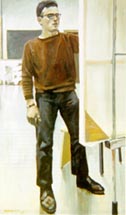 Butch
Hancock, described as one of the best songwriters in America
in the folk-poet tradition, and who is also a photographer and
former architecture student, replies with an answer that is as
good as any. He explains that "all of the winds from the
North Pole come across Kansas until they hit the Yellow House
Canyon and then they spill out in every direction sending all
of the ideas for music [and art] swirling around.' Paul
Milosevich, in the 1970s, was
in the right place at the right time to be blown about by the
blue northers into a head-on collision with a remarkable group
of young musicians, many of whom were also writers and artists. Butch
Hancock, described as one of the best songwriters in America
in the folk-poet tradition, and who is also a photographer and
former architecture student, replies with an answer that is as
good as any. He explains that "all of the winds from the
North Pole come across Kansas until they hit the Yellow House
Canyon and then they spill out in every direction sending all
of the ideas for music [and art] swirling around.' Paul
Milosevich, in the 1970s, was
in the right place at the right time to be blown about by the
blue northers into a head-on collision with a remarkable group
of young musicians, many of whom were also writers and artists.
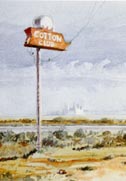 …One of the few night spots for
dancing in Lubbock during the fifties and sixties was the Cotton
Club. The club’s later days (in the late
seventies) were associated with Tommy
Hancock, billed (among many titles) as Tommy
Hancock and the Supernatural Family Band. Hancock
is referred to affectionately as "Lubbock's
original hippie." The no-longer-existent dance
hall was commemorated by Milosevich with a watercolor of the
old sign left standing to blow in the wind above the bare ground.…
…One of the few night spots for
dancing in Lubbock during the fifties and sixties was the Cotton
Club. The club’s later days (in the late
seventies) were associated with Tommy
Hancock, billed (among many titles) as Tommy
Hancock and the Supernatural Family Band. Hancock
is referred to affectionately as "Lubbock's
original hippie." The no-longer-existent dance
hall was commemorated by Milosevich with a watercolor of the
old sign left standing to blow in the wind above the bare ground.…
For decades, Lubbock, the self styled "Hub
of the Plains" drew musicians to its center;
these musicians then fanned out over the country watching the
cotton gins disappear in their rearview mirrors. The early generation
included such names as Plainview singer Jimmy Dean, the late
Roy Orbison from Wink, producer Norman Petty from Clovis, Texas
Tech architectural student John Deutchendorf -- better known
as John Denver, Littlefield's Waylon Jennings, Mac Davis, and
many others. The list comes full circle with the mention of that
founding father of rock 'n roll, Buddy Holly and the Crickets.
It is with the new generation, however,
that this chapter is concerned. This goes back directly to the Flatlanders, a Lubbock band of
the early 1970s that brought together Butch
Hancock, Jimmie Dale Gilmore,
Tony Pearson, and Joe Ely. Other well -knowns include
Ponti Bone, Davis
McClarty, Jesse Taylor,
who are, or 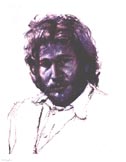 were, members
of Ely's band. were, members
of Ely's band.
The roster continues with the Maines
Brothers, the Nelsons,
Jim Eppler, who was often
painted and sketched by his friend Milosevich, Terry
Allen, as well known as an artist as a musician, and
Jo Harvey Allen, actress
and writer.
The time was ripe not only for new sounds and rhythms but also
for Milosevich’s West Texas realism
and its empathy with the obvious and the overlooked.
It carried the right message and created a link between the painter
and the music people. Milosevich says he met Joe Ely "officially"
at Fat Dawg's and
[I listened] to his music at the
Cotton Club, Main Street Saloon; 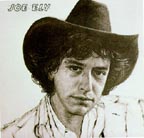 wherever he and his band played I was there
with a sketch pad. I did Joe’s first album cover, a charcoal
portrait. [I] began it about 8 in the morning, and he took it
to California that afternoon. The original got lost out there,
but we were fortunate to have taken good photos of it and made
prints.… wherever he and his band played I was there
with a sketch pad. I did Joe’s first album cover, a charcoal
portrait. [I] began it about 8 in the morning, and he took it
to California that afternoon. The original got lost out there,
but we were fortunate to have taken good photos of it and made
prints.…
Recalling another encounter, Milosevich says, "I met Terry
Allen over the phone." The story goes like this: Terry Allen
and Jo Harvey graduated from Monterey High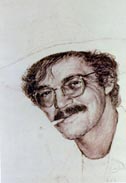 School
in the Hub City and were married. They left the South Plains
as quickly as possible, heading for the West Coast. 'Terry said
in an interview, "I convinced myself when I was growing
up that I hated Lubbock; I made it a scapegoat for everything
that was wrong. . . You never see your hometown until you go
away" School
in the Hub City and were married. They left the South Plains
as quickly as possible, heading for the West Coast. 'Terry said
in an interview, "I convinced myself when I was growing
up that I hated Lubbock; I made it a scapegoat for everything
that was wrong. . . You never see your hometown until you go
away"
It was during a holiday visit to Lubbock that Allen received
the call from Milosevich. The artist had heard that Allen was
in the process of recording some new material and suggested to
Terry that he might want to get in touch with Joe Ely, Lloyd Maines,
and the Caldwell Recording Studio while he was in
town. Later, Allen told Milosevich that he drove around the block
a hundred times trying to make up his mind what to do. He didn’t
want anything to do with Lubbock, but he had a hunch that he
should follow up on Paul's suggestion. The result was the two-record
set Lubbock:
on Everything.
Terry Allen’s attitude towards Lubbock has changed in
the last few years. He admits:
There is something about West Texas
that gets stuck in the bones. That something is never felt stronger
than when a native is several thousand miles from home. Maybe
a chip was planted long before cowchips were outmoded by the
computer. The tendency is for West Texans who develop a case
of nostalgia to come loping home by air or pickup. You go back,
exasperating as it may seem, because you want to go back and
you know damn well there's nothing there except your memories
and your friends and the flat land and the wind; that's enough.
It makes you know who you are and stiffens your back for going
away again.…
Terry Allen’s song "Amarillo Highway" leads south to
Lubbock. Terry says that as long as it's possible to get out
in a car on a starlit night, on a straight road with the radio
turned up high, no one should ever need a psychiatrist.
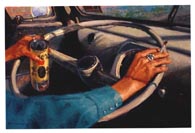 Butch Hancock's
poetry bites through the dryness and unbroken bowl of the sky
to speak up for dirt roads and cattle guards, for trucks and
tractors: Butch Hancock's
poetry bites through the dryness and unbroken bowl of the sky
to speak up for dirt roads and cattle guards, for trucks and
tractors:
This old road is hard as pavement.
Tractors and trailers have sure packed it down,
There's deep ruts and big bumps
from here to the city.
This old road's tough but it sure gets around.
Trucks, pickups, cars, and the sun overhead are signs and
symbols that set wheels in motion and circles spinning. One of
Butch's songs says, "This old world
spins like a minor miracle." Woody Guthrie's
"Car Car Song" is one of the "modern lullabies"
Ely has recently recorded for his daughter. It is no mystery
why David
Byrne chose to open and end the film True Stories with frames of a red
convertible parked on a road that stretched from nowhere to nowhere.
Both beginning and ending are left open ended to reach out to
infinity: "Enlightenment doesn’t care how you get there!"
...Another [Paul] Milosevich painting, this time of a truck,
was a pivotal point of an exhibition hosted in the fall of 1984
by The Museum, Texas Tech University. Future Akins, interim curator
of art, was one of the forces behind the idea of bringing together
artists and musicians in an unexpected three-dimensional, multimedia,
foot stompin’ tribute to West Texas music.…
[Milosevich] painted a West Texas ranch hand sitting in the back
of a pickup and strumming a guitar. Its title, Nothin'Else
to Do, became the name given to the exhibition.
During the ‘fifties and ‘sixties in Lubbock, "nothin’
else to do' meant hangin’ out at the Hi-de-Ho
Drive-in, listenin’ to the radio, or gettin’
together with like-minded friends to do some pickin’ on
the guitar or banjo, playin’ the harmonica or maybe the
saw or washboard, perhaps formin’ a jug band.
An eloquent tribute to Milosevich's painting was written by Mikal
Gilmore:
For me, one of the more memorable
depictions of [the] push-pull between freedom and flight (the
tension at the heart of so much West Texas music) was... a painting
by Paul Milosevich of a young cowhand sitting on the rear end
of a pickup ...
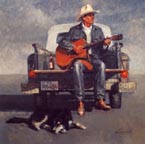 a
look of intense yearning on his face as he stares over the illimitable
Texas flatlands... dreaming a way out of his fateful indolence.
Stationed just in front of the painting was an honest-to-goodness
1957 salmon pink Cadillac with charcoal blue upholstery ... Taken
together, the painting and the car told a timeless, virtually
mythic story of longing and attainment. a
look of intense yearning on his face as he stares over the illimitable
Texas flatlands... dreaming a way out of his fateful indolence.
Stationed just in front of the painting was an honest-to-goodness
1957 salmon pink Cadillac with charcoal blue upholstery ... Taken
together, the painting and the car told a timeless, virtually
mythic story of longing and attainment.
The Cadillac's pink fins pointed towards the heart of the
exhibition, a tribute to C.B. Stubblefield
of the famous Stubb’s
BBQ, and another of Milosevich's friends. From
1969, when the small place on East Broadway was opened, it was
a haven to almost every musician worth his beer, whether from
Lubbock or just passing through. Stubb's Sunday
Night Jam Sessions offered a platform, a bit cramped
in size but big in soul, to those on their way up and those on
their way down. A musician could always count on Stubb's words
of encouragement offered with humor and hot ribs and cold beer.
A few years ago, when Stubblefield was 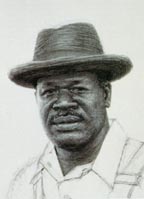 approached
by the Internal Revenue Service, rumor has it, he responded to
their charges of failure to file income tax returns with the
severe logic, "I never made any money, why should I pay
taxes?" approached
by the Internal Revenue Service, rumor has it, he responded to
their charges of failure to file income tax returns with the
severe logic, "I never made any money, why should I pay
taxes?"
One of the legendary events that took place at Stubb's will
challenge generations of folklorists. This is The
Great East Broadway Onion Championship of 1978.
It inspired a Tom T. Hall song by the same name which
appeared in the album, Places Where I've Done Time. It
was also the subject of a black-and-white painting by Milosevich
and Jim Eppler. According to the painter, it all began one evening
when Hall, Paul, Jim Eppler, and "a guy named Al" were
sitting around drinking beer and talking. Hall had never met
Stubb; to remedy this they drove out to East Broadway. When they
got there, Joe Ely was shooting pool in the back room, and before
anyone could say "eight ball," Tom T was in the game.
"Smoke was hangin’ low and thick"; as play accelerated,
it got hotter and hotter, and later and later. Joe's girl friend
Sharon, who is now his wife,
was tired and disgusted, so she pounced on the cue ball and carried
it off. Refusing to be discouraged, Ely reached into a bag of
Stubb's onions, took out a big one, and put it down on the felt
to the disbelief of the kibitzers standing around roaring with
laughter. He announced that he was going to play with a broom
handle, which he did. Milosevich explains that this "cue
stick" really sliced up and punctured an onion 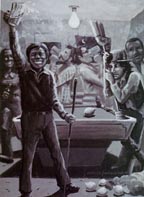 pretty
badly, which meant that the onion had to be replaced from time
to time. When the game ended, the table looked like a green hamburger
covered with chopped onions before the catsup is added. Tears
were streaming from the competitors' eyes as they battled on,
until finally Tom T. was declared the winner of the championship
title. Magnanimously, Joe Ely offered a rematch the following
year, but Hall said, "No. There are a lot of good onion
players out there, and they deserve a shot at the title, too'
" In Milosevich's and Eppler's painting, Tom is grinning
on the left. Ely is easily identifiable by the broomstick he
holds. In the background, Jim Eppler and the painter, drinking
beer, are back to back with profiles facing in opposite directions
like the Roman god Janus. pretty
badly, which meant that the onion had to be replaced from time
to time. When the game ended, the table looked like a green hamburger
covered with chopped onions before the catsup is added. Tears
were streaming from the competitors' eyes as they battled on,
until finally Tom T. was declared the winner of the championship
title. Magnanimously, Joe Ely offered a rematch the following
year, but Hall said, "No. There are a lot of good onion
players out there, and they deserve a shot at the title, too'
" In Milosevich's and Eppler's painting, Tom is grinning
on the left. Ely is easily identifiable by the broomstick he
holds. In the background, Jim Eppler and the painter, drinking
beer, are back to back with profiles facing in opposite directions
like the Roman god Janus.
In 1984, when Stubblefield locked the door of his barbeque
parlor for the last time before moving to Austin, Future Akins
and Clyde Jones, the University Museum director, were on hand
to salvage as much of the history-making memorabilia as possible
and to organize the mementoes into a three-dimensional display
for the Nothin’ Else to Do exhibition. The tribute to Stubb
occupied a display area where the booths and posters were arranged.
Gazing down upon the old piano was a deer's head, glass eyes
staring through dark glasses. Hanging on a wall, the famous sign
announced "There will be no BAD talk or LOUD talk in this
PLACE," and another
placard carried the instructions "Equal
time for all musicians. No more than 2 guitars at a time. Thank
You."
Milosevich says, "Now on East Broadway, where Stubb's little
joint was, there's just a bare concrete slab with a lot of good
vibes still hovering above it. Recently, Stubb stood on that
slab, looking around East Broadway, and then returned his gaze
to the bare concrete. He laughed, "It's like looking at
the bottom of a good cup of coffee!"
Nothin’ Else to Do helped
pave the way for the Texas Tech Museum’s response to the
state's sesquicentennial anniversary in 1986. Gary Edson, Museum
director, and Future Akins, at that time curator of art, planned
an unusual recognition of the musicians and artists who had tapped
the vital forces of the South Plains. A review of the exhibition
in Artspace Magazine describes that background:
In the last decade, chunks of Texas
have been seized by metroplexamania and stamped by the boots
of office cowboys working-out on mechanical bulls. Driving along
West Texas roads, however, a nostalgia for simpler times is still
stirred by songs drifting from jukeboxes in cafes and truck stops.
The songs wail with memories of warm hearts, cold lips, 90 proof
whiskey, and unrequited love. The neon glowing in the blackness,
the music, and rubbin’ elbows inspired Honky Tonk Visions.
Honky Tonk Visions
invited live performances by musicians and art inspired by the
honky-tonk theme. Among those participating, Terry Allen built
a three-dimensional environment that was a tribute to old friends
and memories.
A white wooden bed was the focal point. All over the amorous
piece of furniture there were words from favorite love songs
inscribed in multicolored paints and markers by Lubbock musicians
and high school buddies. The museum staff gasped one afternoon
to see members of the Maines Brothers
Band piling from their bus and running into the gallery
so each could write a few lines. ... On the night that Honky
Tonk Visions opened, the bed was suspended within a room enclosed
by solid walls on two sides and a screen mesh defining the remaining
side. Pierced by emotions, the bed was penetrated by knives,
swords, hatchets, and machetes. . . Every ill-fated lover suffering
from love, deserted by love, abandoned in the mournful words
of country and western music, once slept here...
Return to
Stories or Home
|



